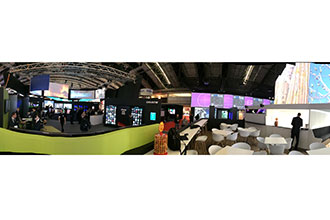ISE Becomes World’s Largest AV Trade Show and Has Six Clear Tech Themes
 Before the doors closed on the 2014 edition of the Integrated Systems Europe (ISE) last week in Amsterdam, The Netherlands, nearly every exhibitor already knew it was a record show. NEC reported to us on Day 2 of the show that they’d seen a 40 percent increase on leads on Day 1 over 2013’s totals. Barco reported similar stats. Same for Sony, Panasonic, Cisco, AOpen, Lighthouse, Peerless-AV and Control4. All reported at least 40 percent increases in leads year over year. Final attendance was 51,003.
Before the doors closed on the 2014 edition of the Integrated Systems Europe (ISE) last week in Amsterdam, The Netherlands, nearly every exhibitor already knew it was a record show. NEC reported to us on Day 2 of the show that they’d seen a 40 percent increase on leads on Day 1 over 2013’s totals. Barco reported similar stats. Same for Sony, Panasonic, Cisco, AOpen, Lighthouse, Peerless-AV and Control4. All reported at least 40 percent increases in leads year over year. Final attendance was 51,003.
ISE is a combo-show in that it combines the best of InfoComm and CEDIA, thus it’s a showing of ProAV and HomeAV products in one giant show venue. But, it also includes an entire hall and a half dedicated to digital signage, one dedicated to nothing but videoconferencing and unified communications providers, one that houses over 40 manufacturers of giant LED screens and one hall that’s nearly exclusively staging rigs, gear and lighting. It’s like a half a dozen shows in one.
What was most interesting to me that, in over 20 years of exhibiting or covering international AV trade shows all over the world, I’ve never seen so many North American-based dealers and integrators walking a show outside of the USA. This may seem like a minor point, but, if you think about it, for years — well for over 20 years, international integrators have been coming over to the U.S. to attend AV shows like InfoComm and CEDIA Expo and now the tables are turned. And, as ISE falls right after CES and a full four months before InfoComm and seven months before CEDIA, it makes sense that ISE will just continue to grow. And, I’ll bet that more U.S. integrators will attend as 2014 marked a record number of product introductions at ISE. And, we know this for sure as we actually shot videos of all of them and posted them all on this site. Well over 1,000 new products.
And, for 2014, there were a few clear themes that you should know about as, not only will they be themes at InfoComm, but the will change integration of AV forever:
1. 4K isn’t 3D: A few years ago, 3D was all the rage. But, alas, it was hype. Not 4K. 4K is the real deal and will, in fact, have a huge impact on ProAV faster than any new display technological evolution in the last 15-years. And, no, not because of image quality. Yes, for the HomeAV market, the impact of image quality will drive 4K. But, the adoption curve will be way slower. Where 3D was driven by the consumer market and trickled up to ProAV, 4K will be driven by the ProAV market and will trickle down to the HomeAV market — when content is available. That will be a year or two away for most of us.
But, with 4K in ProAV systems, the impact will be quick and by InfoComm, some of you will have actually already integrated 4K systems in to meeting rooms and classrooms. Why? Well, 4K makes multi-imaging awesome. And, as you’ll see from theme number two (see #2 below), multi-imaging content, presentations and video is something we will all find very easy to do and something clients will ask us to do as fast as we can. Currently, using a 1080p projector or even a WUXGA resolution one and then sharing the screen between a videoconference an a Powerpoint presentation leaves a lot to be desired. The shrunk-down images and resolution, make the content quality poor. But, imaging building rooms where the screen is filled with native 1080p content (not scaled down) and a Powerpoint shown side by side and both in native resolutions — wow!
But, you’re only thinking short term if you see that as the wow’ing solution for your clients. Here’s where 4K will be big. Imagine replacing the entire (or most of it, anyway) with a giant projection screen and filling the front of the room with native content. You see, for years, we’ve designed rooms with the projection screen size based on the least-favored viewer (the guy sitting at the back of the room). And, with a single image projected on a screen, this makes sense as that image fills the screen. But, the trend in “collaboration” (that word being used for sharing multiple types of content on the same screen (e.g., a Powerpoint presentation and a website at the same time), with 4K you don’t need to lose resolution. And, in that case, both images should be considered — size wise — when sizing the screen for the least favored viewer. Thus, the screens need to be gigantic. Yes, it’s sort of like changing the way we envision a screen into more of the way an IMAX theater is built. And this makes sense. Shrinking down images to display them side by side means that people in the room can’t see the content being displayed. But, keeping the content the same size as specified by room design criteria, means that you need a much bigger screen when displaying two things (or more) at the same time. Think Barco ClickShare, WOW Vision and Christie Brio sharing on the screen you now have in most rooms you designed versus what I am proposing and envisioning. Do it my way and you’ll see all the detail of all four images being displayed no matter where you sit in the room.
So, Da-Lite, Draper, DNP, Projecta, et al. you need to start making larger screens as standard sizes — not custom orders!
2. Collaboration: Collaboration means different things in different markets. In the ProAV market, however, it means sharing multiple pieces of content on the screen simultaneously. So, while making a Powerpoint presentation, you can bring up a website or a spreadsheet and display both of them at their native resolution — so everyone can see everything. Well, at ISE 0214, there were a half-dozen new versions of this from companies like Christie, Sony, WOW Vision, Cisco, Panasonic and a couple I can’t talk about as they were shown to me privately — but, know they are BIG companies.
Sharing content this way is being made possible via two technological advances: the network and the devices. The network (wired or wireless) is capable of delivering any type of content to us without it ever getting on a VGA, HDMI, DisplayPort or DVI connector. And, it’s only a matter of time before projectors and LCDs have built-in network ports that play all types of content without a media player. Did you know that Barco’s already building its ClickShare wireless system into a few lines of projectors? You think we’re far from Sony, Christie and companies like Extron and Crestron doing it? Sure, there’s no way this concept of building systems will be the majority of the market over the next five years, but it will be a significant chunk of it — thus, the devices.
3. Cloud-Based Conferencing: On done form or another, every VTC and UC company that exhibited at ISE showed cloud-connectivity. Some are actually moving towards placing the entire codec in the cloud (like Pexip and Blue Jeans) or are allowing cloud connectivity (connectivity in to a video call via a browser) like the way Cisco and Polycom are doing it. And, then you have Skype (Microsoft will make its AV debut at InfoComm) and Lync and a few other competing “standards” on the horizon. However you do it, you will ALL be integrating Videoconferencing and/or (hopefully or as it’s better) unified communications as the network and the gear is way easier to do this (and fully integrate it in to an AV system) than it ever has been. In the 1990s when this stuff debuted, the phone companies couldn’t deliver on ISDN and T-1s as promised. Then, in the 2000s, the network wasn’t reliable or fast enough. Now, it all just works. And, the gear is easy to integrate and use.
4. Social Media Monitoring NOCs: Yes, the future of network operations centers (NOCs) and command and control systems is not limited to utilities, cities, governments and oil and gas. In fact, the real growth is in social media marketing. No other application is as data intensive as monitoring the thousands of daily mentions on Twitter, Facebook, Instagram, LinkedIn, Pinterest, Vine, WeChat and the handful of other social media tools currently being used to mention company names, complain about customer service or ask for help for big brands. And, brands will be wanting to monitor it all just like a city monitors security and a gas company monitors all their assets. This will be huge and integrators will be integrating thousands of these command centers this year. This market will dwarf the current NOC market within three years. I guarantee it!
5. Digital Signage Simplicity: ISE brought more digital signage products than I’ve ever seen — way more than at the annual DSE — Digital Signage Expo. But DSE is in Las Vegas so the two don’t really compete as DSE is mostly a U.S. show. Most digital signage manufacturers were heading to DSE this week – directly from ISE – and so are we. We have a dedicated DSE MicroSite here (where we’ll post all the show videos we shoot, blogs and news too: www.ravepubs.com/dse2104. But, what’s happened at DSE was the simplicity of the DS system – thanks to the new generation of media players, was evident. Digital signage is for more than IT and HomeAV integrators now – ProAV is getting it.
6. Dante Dominates Networked Audio: There isn’t a single audio manufacturer that matters not using Audinate’s Dante for networking audio. Every company is doing it now — with Extron, Atlas Sound and Crestron being the latest two to announce it. You will be integrating all your audio on the network by the end of 2015. All of it.
Certainly, this doesn’t cover everything that my team saw at ISE. We had 17 reporters at ISE and we shot over 1200 videos, 1000 photos, 15 podcasts and 300 news stories and blogs and you can see it all here. I hope it helps you find the new products you’re looking for.





